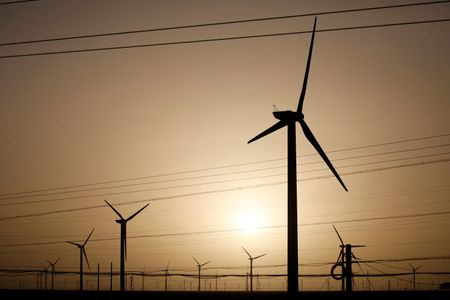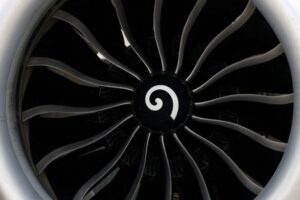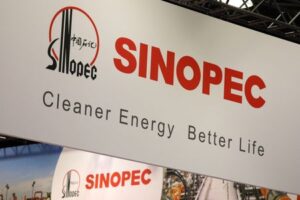By Riham Alkousaa, Christoph Steitz and Nina Chestney
BERLIN/FRANKFURT/LONDON (Reuters) – Chinese wind turbine-makers this month clinched their first order in Germany, as they build momentum in the European market and add to concern in the EU industry that it faces an existential threat.
Tensions are high between Beijing and Brussels, the world’s two biggest wind markets, as the European Commission, the EU executive, has launched an investigation into whether Chinese players enjoy unfair subsidies.
Europe is scarred by the experience of its solar industry more than a decade ago when policymakers took limited action to curb Chinese imports and many European manufacturers collapsed.
Chinese manufacturers Goldwind, Mingyang Smart Energy and Windey so far account for less than 1% of Europe’s wind capacity, but their orders amounted to 1.2 gigawatts (GW) in 2023 alone, WindEurope data shows. It previously took them a decade to install that volume.
So far this year, European orders for Chinese-made turbines have reached 546 megawatts (MW).
That includes an order at the start of this month from project firm Luxcara in Germany with Mingyang for wind turbines with a total capacity of 296 MW. It was the first order for Chinese-made turbines from Europe’s biggest economy and the German government said it would examine the decision closely.
European industry officials say China could be in Europe to stay.
“Once you open the door you can’t close it again,” said Wolfram Axthelm, managing director of Germany’s wind power association BWE, adding that overcapacity meant Chinese rivals were seeking to flood the European market.
None of the companies would comment on claims by European industry representatives that Chinese manufacturers offer incentives, such as deferred payments, and prices that are up to 50% lower those of than European rivals.
According to the Global Wind Energy Council, China has production capacity of around 82 GW, more than the domestic market was able to absorb last year and nearly four times Europe’s capacity.
The Chinese Wind Energy Association said Europe needed to buy equipment from China, and that failing to do so would put EU expansion targets at risk “in the face of Europe’s wind power production capacity gap”.
VISIT TO CHINA
Major wind project developers such as EnBW and BayWa have so far avoided the use of Chinese turbines.
In a LinkedIn post in early July, RWE’s head of offshore wind Sven Utermoehlen said he had visited Mingyang’s production facilities to get a better understanding of its products. The visit took place at the end of June.
RWE, the world’s second-biggest offshore wind farm developer, told Reuters it wanted to keep working with established firms.
However, strong market growth meant it needed to understand whether Asian suppliers “can meet our requirements in terms of technology, quality, safety and cost-effectiveness”.
Mingyang was the only company that would guarantee delivery of an 18.5 MW model by 2028, Luxcara said.
An 18 MW offshore turbine can produce enough power to supply more than 30,000 households.
The ambition of the Chinese companies is apparent in the size of their output. Mingyang makes offshore turbines with rotor diameters of 260 metres, among the biggest in the industry.
WILL CHINA START PRODUCING IN EUROPE?
Despite the challenge of shipping gigantic equipment, Mingyang and most other Chinese turbine makers have no production facilities in Europe.
Vensys, a division of Goldwind is an exception. It plans to produce an 86-metre wind turbine blade model at its factory in Ferreira, Spain, it told Reuters in June, without providing further details.
Zhenshi Holding Group in March acquired an Airbus factory in Spain to manufacture wind turbine blades, according to real estate firm Colliers, which advised on the transaction.
Evgenia Golysheva, VP Strategy and Operations at ONYX Insight, a renewable technology firm that helps to service wind turbines, said the companies would need local production. Without it, they would struggle to maintain equipment without shipping parts huge distances.
Chinese wind turbine maker Sany said last year it was weighing the construction of a turbine plant in Europe. It has hired former executives from Siemens Gamesa and Nordex to strengthen its local team, updated LinkedIn profiles showed.
Sany was not available for comment for this story and Goldwind and Zhenshi declined to comment.
Mingyang said Chinese competition was beneficial to Europe, although it understood not everyone would welcome it.
“Some competitors … don’t want us to be in Europe. It can be understandable,” Zhang Qiying, chief technology officer of Mingyang, told Reuters.
“If the West demands our turbines, then we will be there.”
($1 = 0.9173 euros)
(Reporting by Riham Alkousaa and Markus Wacket in Berlin, Christoph Steitz in Frankfurt and Nina Chestney in London; Additional reporting by Pietro Lombardi in Madrid and Colleen Howe in Beijing; Editing by Barbara Lewis)





